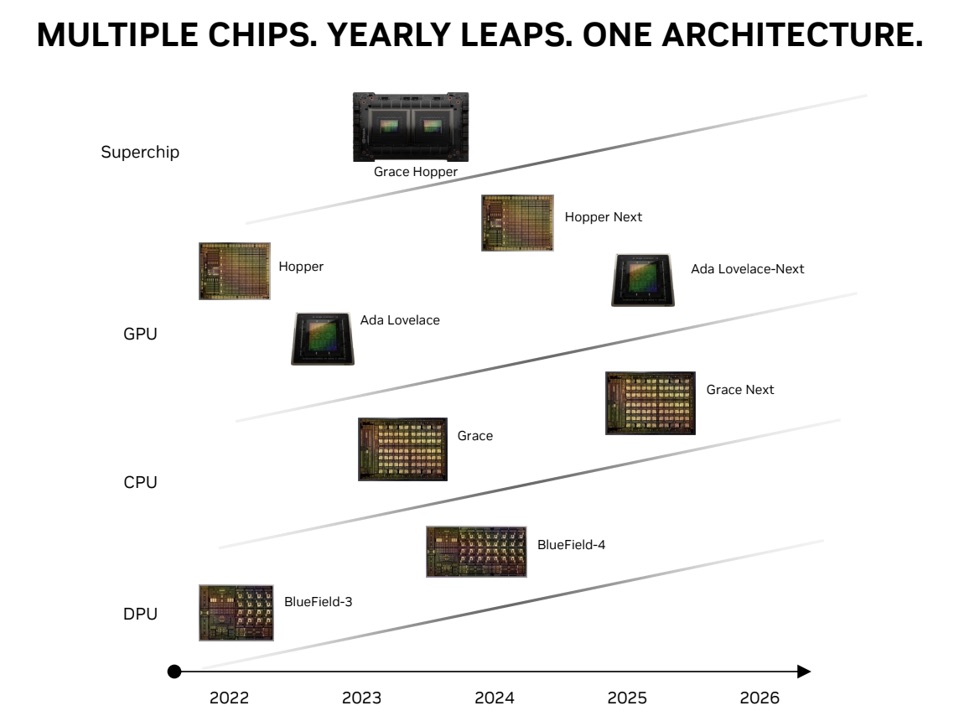Nvidia's next-generation GPUs will arrive in 2025 and slightly later than expected
It's not a huge delay, but it's still disappointing.

A slide released by Nvidia as part of a briefing on AI training performance appears to have revealed the launch date of its next gaming graphics architecture. The slide, spotted by Hardwareluxx, places "Ada Lovelace-Next" in 2025.
That's unambiguously later than most industry observers have been expecting. Nvidia's existing Ada Lovelace GPUs form the basis of all current RTX 40-series cards, including the RTX 4090, 4080, 4070 Ti, 4070, 4060 Ti and the latest addition in the 4060. The first Ada Lovelace GPUs were announced in September last year and went on sale in October.
The usual cadence for new GPU architectures is generally assumed to be two years, putting the launch date of first members of Nvidia's next-gen GPU family in fall next year. However the slide clearly places Ada Lovelace-Next in 2025.
Inspecting the slide more closely, the precise positions of various architectures does seem indicate not just the year of launch but a more precise timeframe. On that basis, Ada Lovelace-Next's launch looks to be slated for spring 2025.
If that's correct, the "delay" versus loose expectations would be around six months. So not huge, but still a little disappointing. That's especially true when you consider how meagre the performance gains Nvidia is delivering with Ada Lovelace over the previous Ampere generation.
Nvidia itself, for instance, is only claiming 20% raster performance boost for the new RTX 4060 over the RTX 3060. If Nvidia shifts to a 2.5-year cadence for new GPU launches, a 20% gen-on-gen performance increase would mean it takes fully a decade to double baseline raster performance. Yuck.

Incidentally, the slide does not reveal the codename for Nvidia's next GPU family. Most previous rumours refer to it as Blackwell, but that has not been officially confirmed.
Keep up to date with the most important stories and the best deals, as picked by the PC Gamer team.
Of course, the immediate question is why Nvidia would want to slow down the schedule for new GPU launches. One obvious explanation, for this generation at least, is slow GPU sales.

Best CPU for gaming: The top chips from Intel and AMD
Best gaming motherboard: The right boards
Best graphics card: Your perfect pixel-pusher awaits
Best SSD for gaming: Get into the game ahead of the rest
If Nvidia wants to maintain the return on investment it normally expects from a given GPU family, slow sales would mean extending that generation's lifetime to allow more time to hit overall sales volumes targets.
There are plenty of other possibilities. Shrinking transistors isn't getting any easier and the engineering and design work for each new node is generally thought to be getting harder. Likewise, Nvidia's plans for its next GPU family will need to align with whatever foundry service it plans to use.
Maybe there's something going on at TSMC that forces this schedule. For instance, if Nvidia wanted to produce this generation of GPUs at TSMC's new US-based fabs in Arizona, maybe that would force a 2025 rather than 2024 launch.
We'll probably never know for sure. But there is one thing we can say. We hope this isn't the beginning of a broader trend for longer GPU life cycles.

Jeremy has been writing about technology and PCs since the 90nm Netburst era (Google it!) and enjoys nothing more than a serious dissertation on the finer points of monitor input lag and overshoot followed by a forensic examination of advanced lithography. Or maybe he just likes machines that go “ping!” He also has a thing for tennis and cars.

